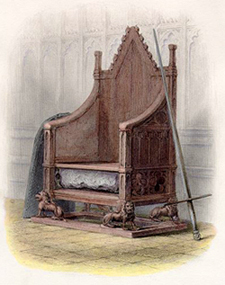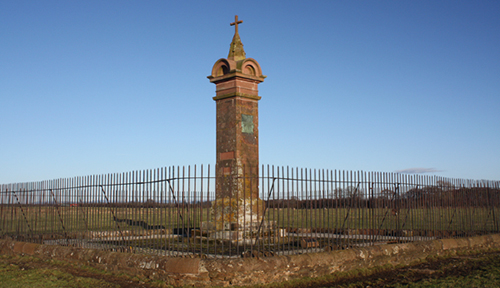King Edward I - Part 5
 As if Edward didn't have problems enough, there was a new Welsh uprising also at this time led by the new rebel leader: Madog ap Llewellyn which he would have to deal with! However, once again with characteristic strength in leadership, King Edward had put down the Welsh rebellion by the spring of 1295 and in March of the following year, he led an army of 25,000 men north to Berwick determined not just to put down a rebellion but indeed to conquer Scotland. By the end of June 1296, Balliol had surrendered and Edward had put in place three English magnates who would rule the kingdom for him. As a mark of his victory, Edward took the Stone of Destiny which had always been the symbol of Scottish kingship, and installed it in the Coronation chair in Westminster Abbey. (Pictured right) It would remain there for the next 700 years only being returned to Scotland in 1996! He also took the Great Seal. The troubles in Scotland did not end there however, and right up to the end of his reign, Edward would be trying to put down rebellions in Scotland. His sometimes brutal tactics and frequent campaigns against the Scots earned him the epithet: 'the Hammer of the Scots'. (The Scottish Nationalist leader William Wallace was hung drawn and quartered in London in 1305)
As if Edward didn't have problems enough, there was a new Welsh uprising also at this time led by the new rebel leader: Madog ap Llewellyn which he would have to deal with! However, once again with characteristic strength in leadership, King Edward had put down the Welsh rebellion by the spring of 1295 and in March of the following year, he led an army of 25,000 men north to Berwick determined not just to put down a rebellion but indeed to conquer Scotland. By the end of June 1296, Balliol had surrendered and Edward had put in place three English magnates who would rule the kingdom for him. As a mark of his victory, Edward took the Stone of Destiny which had always been the symbol of Scottish kingship, and installed it in the Coronation chair in Westminster Abbey. (Pictured right) It would remain there for the next 700 years only being returned to Scotland in 1996! He also took the Great Seal. The troubles in Scotland did not end there however, and right up to the end of his reign, Edward would be trying to put down rebellions in Scotland. His sometimes brutal tactics and frequent campaigns against the Scots earned him the epithet: 'the Hammer of the Scots'. (The Scottish Nationalist leader William Wallace was hung drawn and quartered in London in 1305)
 The end came to Edward whilst on yet another Scottish campaign by which time he was old and infirm. After visiting Carlisle, he had moved on firstly to Lanercost Priory where he rested awhile, then to an encampment at Burgh by Sands on the Solway Firth where he died of dysentery on the 7th July 1307.
The end came to Edward whilst on yet another Scottish campaign by which time he was old and infirm. After visiting Carlisle, he had moved on firstly to Lanercost Priory where he rested awhile, then to an encampment at Burgh by Sands on the Solway Firth where he died of dysentery on the 7th July 1307.
He had reigned for 35 years. Today, a monument with a cross (photo left) marks the spot where this great king died at the age of 68 leaving the total domination of Scotland as possibly the only ambition he did not achieve.


